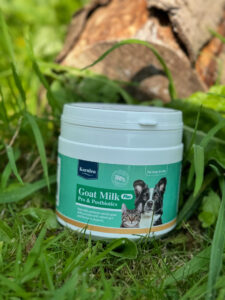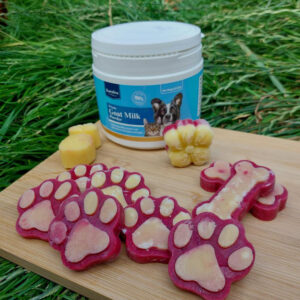Microbiome, gut flora, good bacteria, bad bugs, intestinal microecology, a whole host of germs, whatever you call it, this incredible collective is one of your dog’s greatest mediators of health. I liken the microbiome to your dog’s Ecosystem, a Physical Environment (GI Tract) that hosts Interacting Organisms (bacteria, archaea, fungi, protists and viruses) to create a Biological Community et voila we have the microbiome! Let’s take a closer look at each component
Physical Environment
Going from nose to tail, the GI Tract is responsible for ingesting, absorbing and processing food from start to finish. The GI microbiome is housed predominantly in the Colon, also known as the large intestine.
Interacting Organisms
A diverse group of an estimated 100 trillion microbial cells. Some researchers have even likened this microscopic party to an organ in its own rights, given its huge impact on overall health.
Biological Community
The microbiome became an area of interest in human research in the late 90’s, but for our pets we are just getting started! Research has found that, “composition of the gut microbiome in dogs is correlated with overall health”. (Pilla, R et al. 2020) Anything that can potentially help with my dog’s overall health, I’m all ears!
Like any Ecosystem, the equilibrium can easily be disrupted by a variety of biochemical processes and or environmental toxins.
Inflammation
Inflammation is an important step in the body’s healing process, however when left unchecked inflammation can become an issue in its own right. Inflammation can occur from food intolerances, digestive upset but also systemic inflammation from an orthopaedic condition such as osteoarthritis. Research indicates that there is, “critical interplay between the gut microbiota and inflammation that could inform therapeutic intervention” (Bander, Z et al. 2020) Caring for the microbiome may support a holistic management plan of various inflammatory conditions.
Emotional Stress
The primary stress chemical is Cortisol, we do need certain levels of this to manage metabolism, movement and immune function. We don’t get to decide what is a stressful event for our dog, they do. Examples could range from a trip to the Vets, introducing an additional dog to the household and or reactivity to traffic. Recognising potential stressors in our dog’s lives means we can begin to understand their overall stress load. Researchers found that excess levels of stress have the potential to deplete microbiome diversity. (Bharwani, A et al. 2015)
Pharmaceuticals
The joy of modern medicine is that we can quickly target treatment towards different ailments. For example if your dog has a pesky ear infection, they may be provided antibiotics. Even though medication gets the job done and kills off that ‘bad bacteria’ the drawback we have is that it also wipes all the lovely ‘good bacteria’. It is well recognised in research that, “Antibiotics disrupt the microbial balance and hence the networking within the bacterial community, and that with the host.” (Patangia, D et al. 2022) This doesn’t mean we shun pharmaceutical intervention, but it is important to have strategies in place to recolonise the ‘good bacteria’.
We now know what the microbiome is, and factors that can deplete its diversity so how can Karnlea help?
Hydration
Karnlea has a delicious range of Bone Broths, Fish, Chicken, Lamb and Beef. Not only can Karnlea Bone Broths be used to promote hydration but research indicates hydration factors in the shaping of the gut microbiome diversity. (Vanhaecke, T et al. 2022)
Pumpkin Power
Karnlea Organic Pumpkin Powder is a great addition to any dog bowl with its natural prebiotic fibre. Research also found that pumpkin in fact changed the structure of the gut microbiome. (Liu, G et al. 2018) Not only a tasty way to supercharge the bowl but supporting microbiome health, winner winner!
Goat Milk Goodness
Karnlea Whole Goat Milk Powder and Goat Milk Plus is a nutritious whole food supplement. Another tasty way to encourage hydration but also may increase the abundance of ‘good bacteria’ in the microbiome. (Li, N et al. 2020)
Bharwani A et al. (2015) Structural & functional consequences of chronic psychosocial stress on the Microbiome & Host, Psychoneuroendocrinology. Available at: https://pubmed.ncbi.nlm.nih.gov/26479188/ (Accessed: 01 September 2024).
Li N; et al (2020) Cow, goat, and mare milk diets differentially modulated the immune system and gut microbiota of mice colonized by healthy infant feces, Journal of agricultural and food chemistry. Available at: https://pubmed.ncbi.nlm.nih.gov/33300339/ (Accessed: 01 September 2024).
Liu, G et al. (2018) Pumpkin polysaccharide modifies the gut microbiota during alleviation of type 2 diabetes in rats, International journal of biological macromolecules. Available at: https://pubmed.ncbi.nlm.nih.gov/29702167/ (Accessed: 01 September 2024).
Patangia, D.V. et al. (2022) Impact of antibiotics on the human microbiome and consequences for host health, MicrobiologyOpen. Available at: https://www.ncbi.nlm.nih.gov/pmc/articles/PMC8756738/ (Accessed: 01 September 2024).
Pilla, R. and Suchodolski, J.S. (2020) The role of the canine gut microbiome and metabolome in health and gastrointestinal disease, Frontiers in veterinary science. Available at: https://www.ncbi.nlm.nih.gov/pmc/articles/PMC6971114/ (Accessed: 01 September 2024).
Vanhaecke, T et al. (2022) Drinking water source and intake are associated with distinct gut microbiota signatures in US and UK populations, The Journal of nutrition. Available at: https://pubmed.ncbi.nlm.nih.gov/34642755/ (Accessed: 01 September 2024).



